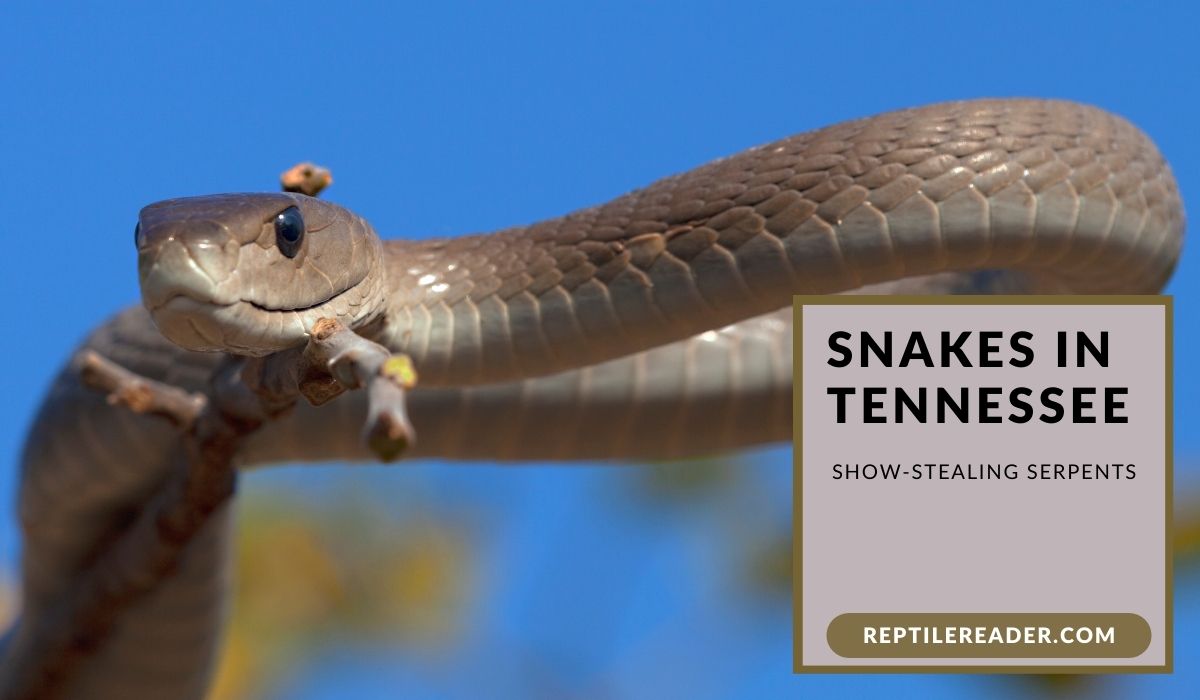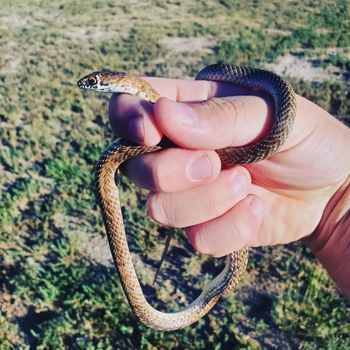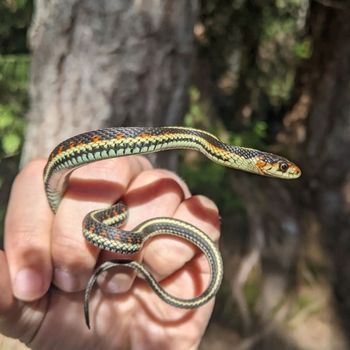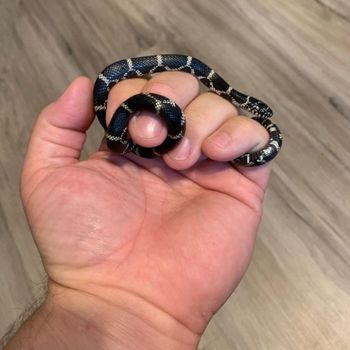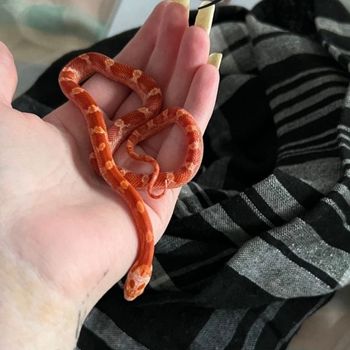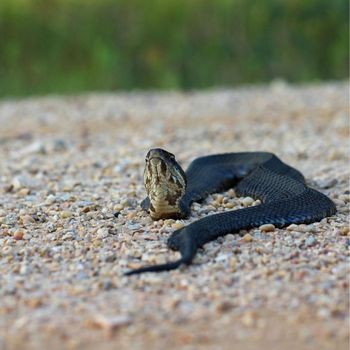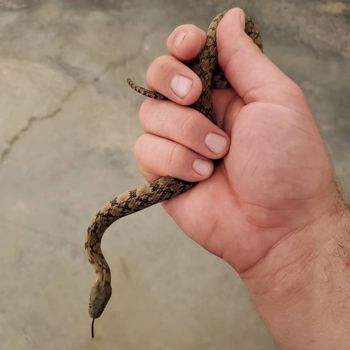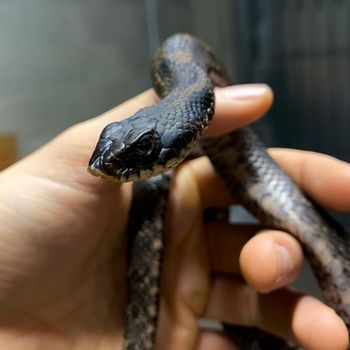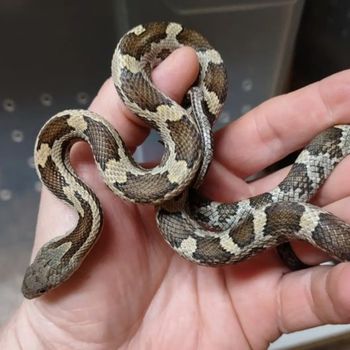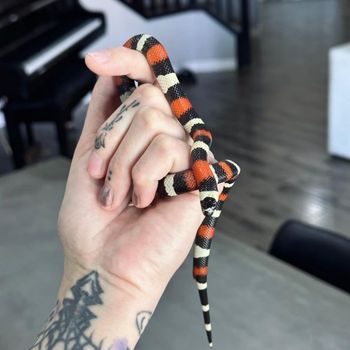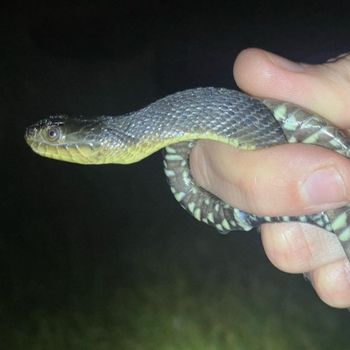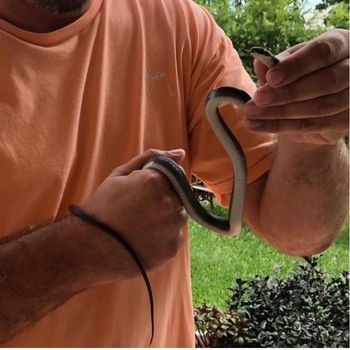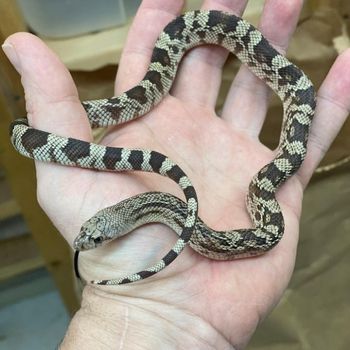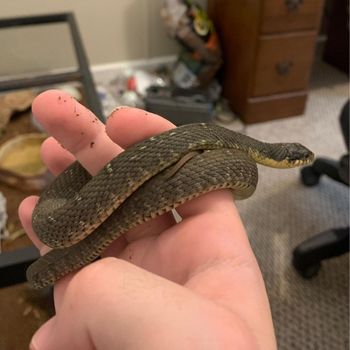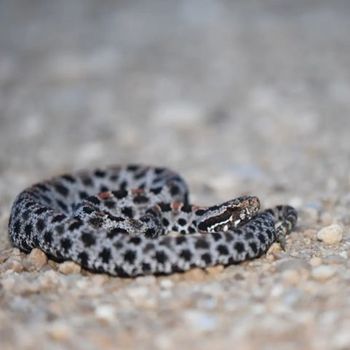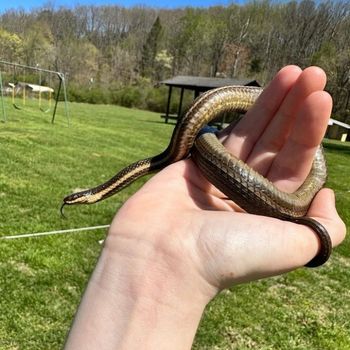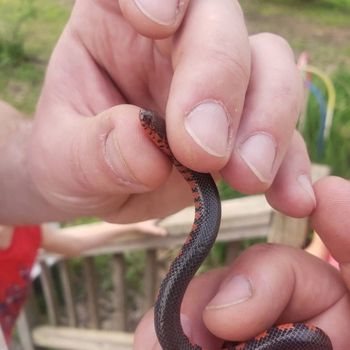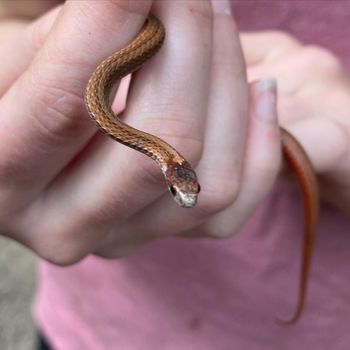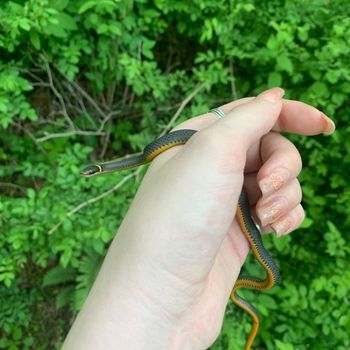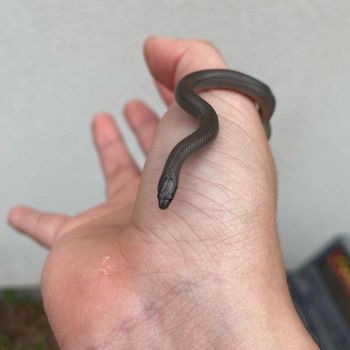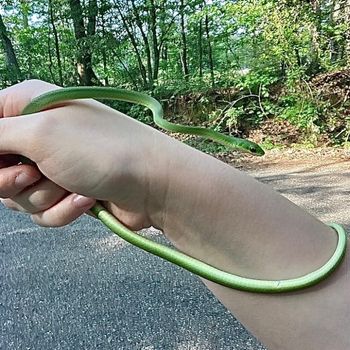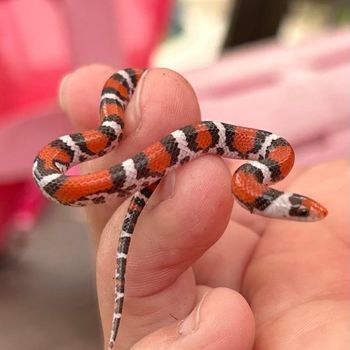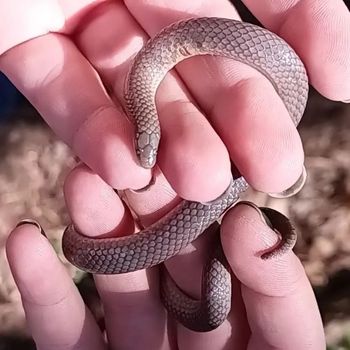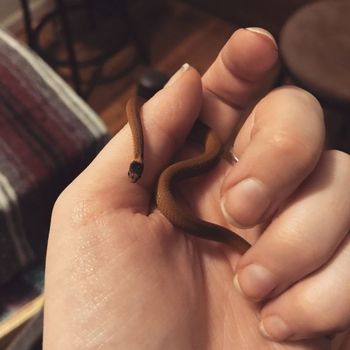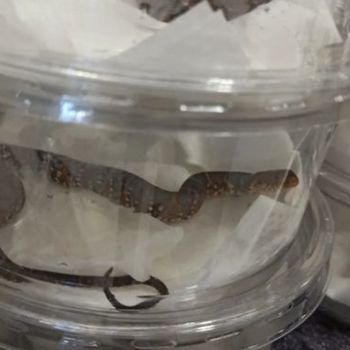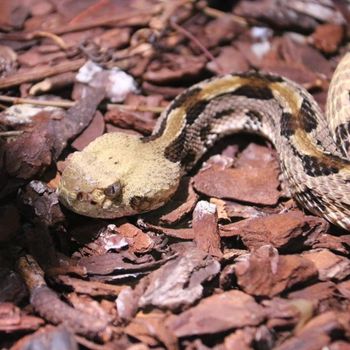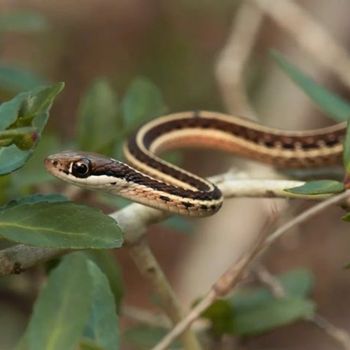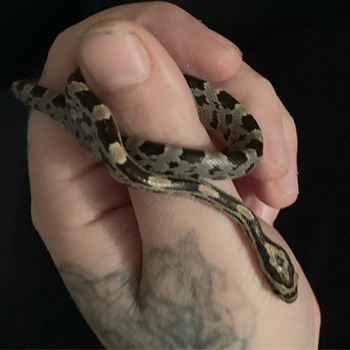Snakes in Tennessee: Show-Stealing Serpents
Well, hello there fellow snake enthusiasts! Did you know that Tennessee is home to a whopping 31 species of our slithery friends? That’s right, the Volunteer State has got an impressively diverse array of serpents for you to appreciate.
So, whether you’re an experienced herpetologist or just a curious observer, there’s always something new and exciting to discover about the snakes that call Tennessee home.
In this blog post, we’ll introduce you to these fabulous creatures, their unique features, and where you might be lucky enough to spot them in the wild. Stay tuned!
| # | Name | Details | Image |
| 1 | Coachwhip Snake (Masticophis flagellum) |
| 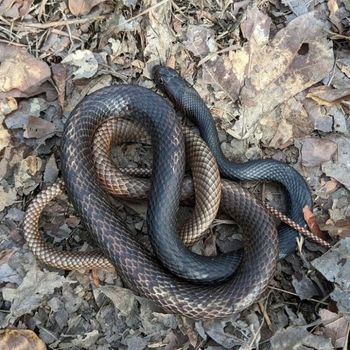 |
| 2 | Common Garter Snake (Thamnophis sirtalis) |
| 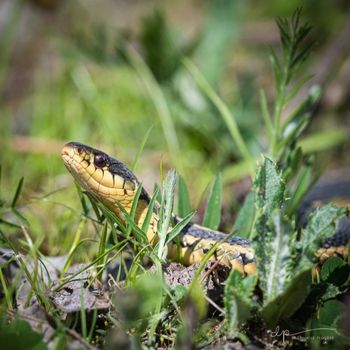 |
| 3 | Common Kingsnake (Lampropeltis getula) |
| 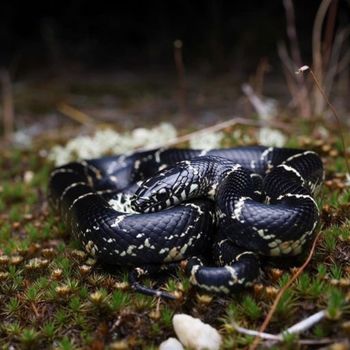 |
| 4 | Copperhead (Agkistrodon contortrix) |
| 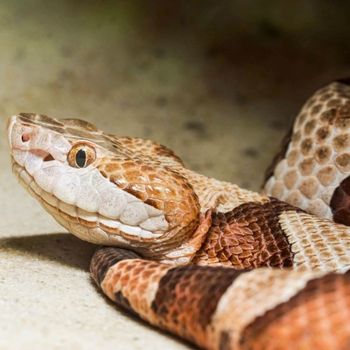 |
| 5 | Corn Snake (Pantherophis guttatus) |
| 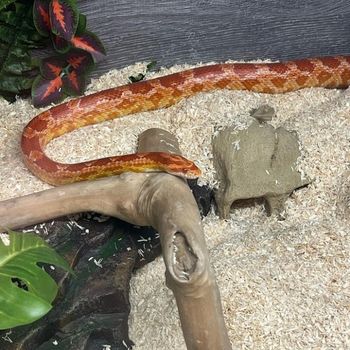 |
| 6 | Cottonmouth (Agkistrodon piscivorus) |
| 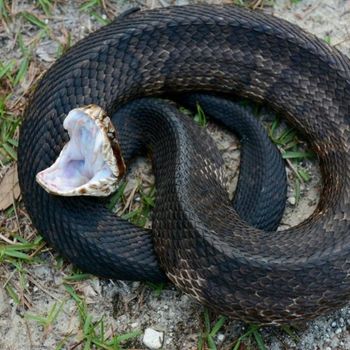 |
| 7 | Dekay’s Brownsnake (Storeria dekayi) |
| 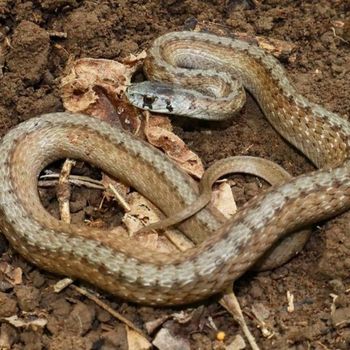 |
| 8 | Diamond-backed Water Snake (Nerodia rhombifer) |
| 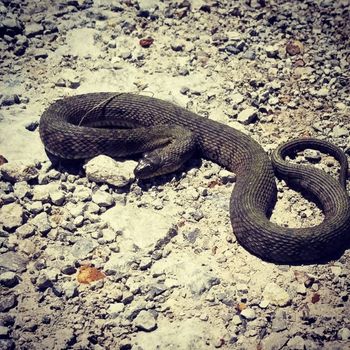 |
| 9 | Eastern Hog-nosed Snake (Heterodon platirhinos) |
| 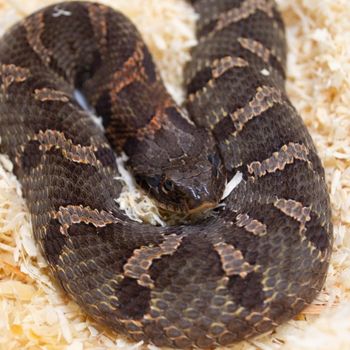 |
| 10 | Grey Rat Snake (Pantherophis spiloides) |
| 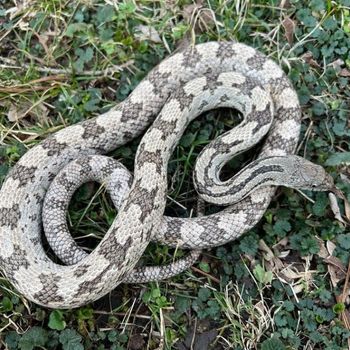 |
| 11 | Milksnake (Lampropeltis triangulum) |
| 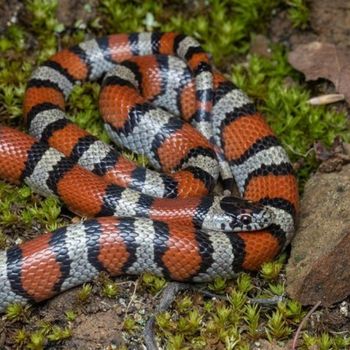 |
| 12 | Mississippi Green Water Snake (Nerodia cyclopion) |
|  |
| 13 | North American Racer (Coluber constrictor) |
| 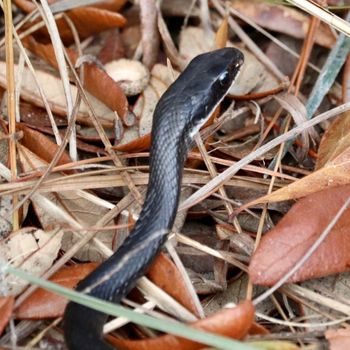 |
| 14 | Northern Water Snake (Nerodia sipedon) |
|  |
| 15 | Pine Snake (Pituophis melanoleucus) |
| 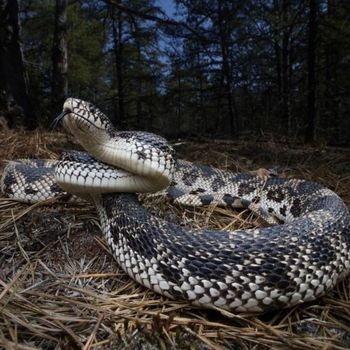 |
| 16 | Plain-bellied Watersnake (Nerodia erythrogaster) |
| 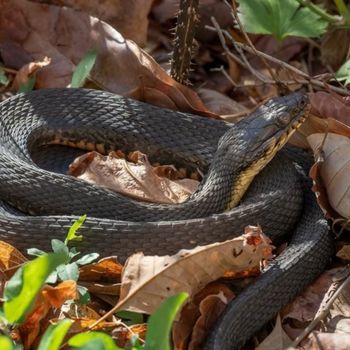 |
| 17 | Pygmy Rattlesnake (Sistrurus miliarius) |
|  |
| 18 | Queen Snake (Regina septemvittata) |
| 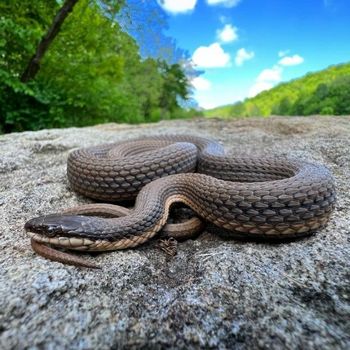 |
| 19 | Red-bellied Mud Snake (Farancia abacura) |
| 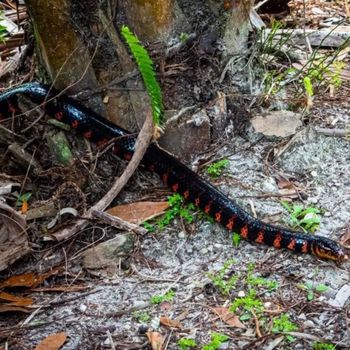 |
| 20 | Red-Bellied Snake (Storeria occipitomaculata) |
|  |
| 21 | Ringneck Snake (Diadophis punctatus) |
|  |
| 22 | Rough Earth Snake (Virginia striatula) |
|  |
| 23 | Rough Green Snake (Opheodrys aestivus) |
| 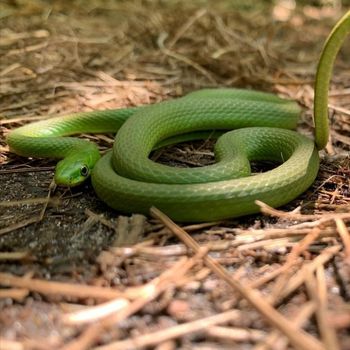 |
| 24 | Scarlet Snake (Cemophora coccinea) |
| 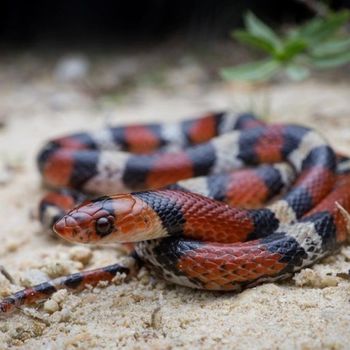 |
| 25 | Smooth Earth Snake (Virginia valeriae) |
| 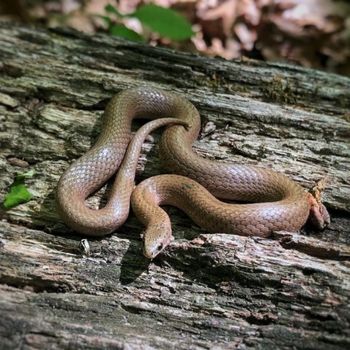 |
| 26 | Southeastern Crowned Snake (Tantilla coronata) |
| 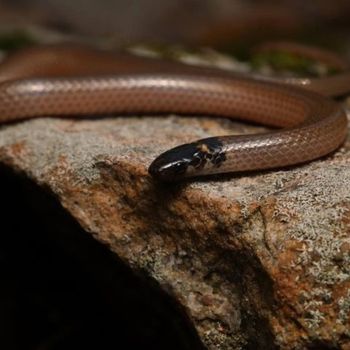 |
| 27 | Southern Watersnake (Nerodia fasciata) |
| 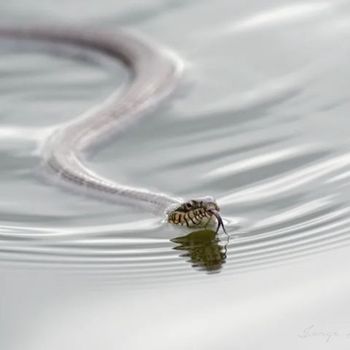 |
| 28 | Timber Rattlesnake (Crotalus horridus) |
|  |
| 29 | Western Ribbonsnake (Thamnophis proximus) |
| 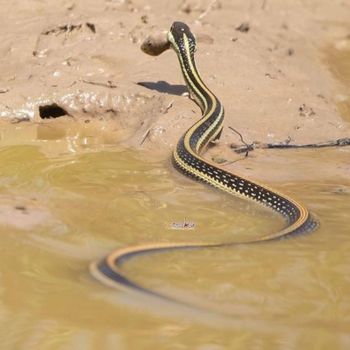 |
| 30 | Western Wormsnake (Carphophis vermis) |
| 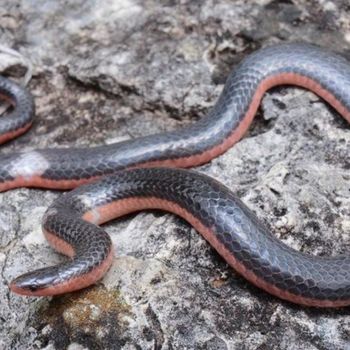 |
| 31 | Yellow-bellied Kingsnake (Lampropeltis calligaster) |
| 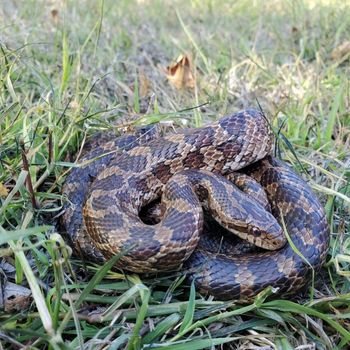 |
31 Snakes You Can Find in Tennessee
In the state of Tennessee, a fascinating array of serpents can be found slithering through its diverse landscapes. From venomous to harmless, each species has its unique story to tell. Below, we’ll explore the wonders of these often misunderstood creatures of Tennessee, from their natural habitats and behaviors to the challenges they face in our changing world.
1. Coachwhip Snake
- Scientific Name: Masticophis flagellum
- Common Name: Coachwhip snake
- Size: Up to 8 feet (2.4 meters)
- Natural Habitat: Deserts, grasslands, and woodlands
- Color: Variety of colors, including tan, brown, pink, and black
- Habitat: Deserts, grasslands, and woodlands
- Maximum Size: Up to 8 feet (2.4 meters)
- Diet: Lizards, small mammals, birds
- Reproduction: Lay eggs in clutches of 3-15
- Venom: Non-venomous
- Conservation: Least concern
The Coachwhip Snake, scientifically known as Masticophis flagellum, is a swift, diurnal serpent native to deserts, grasslands, and woodlands. Growing up to 8 feet (2.4 meters) long, this non-venomous snake displays a variety of colors, from tan, brown, pink, to black. As adept hunters, Coachwhip Snakes primarily feed on lizards, small mammals, and birds. Mating leads to egg clutches ranging from 3-15. Despite their striking appearance, their conservation status remains classified as least concern.
2. Common Garter Snake
- Scientific Name: Thamnophis sirtalis
- Common Name: Common garter snake
- Size: Up to 3-4 feet (0.9-1.2 meters)
- Natural Habitat: Wet and moist habitats, including marshes, fields, and forests
- Color: Green or brown with three yellow stripes
- Habitat: Wet and moist habitats, including marshes, fields, and forests
- Maximum Size: Up to 3-4 feet (0.9-1.2 meters)
- Diet: Frogs, fish, earthworms, and small mammals
- Reproduction: Gives birth to live young, 10-40 per litter
- Venom: Mildly venomous, harmless to humans
- Conservation: Least concern
The Common Garter Snake (Thamnophis sirtalis) is a 3-4 feet (0.9-1.2 meters) non-aggressive and mildly venomous reptile with a green or brown body and three yellow stripes. Inhabiting wet and moist habitats like marshes, fields, and forests of Tennessee, these diurnal snakes hibernate during winter to escape the cold. Their diet consists of frogs, fish, earthworms, and small mammals. Uniquely, these snakes birth live young, producing 10-40 per litter. Although venomous, they pose no threat to humans and are currently listed as a species of least concern for conservation.
3. Common Kingsnake
- Scientific Name: Lampropeltis getula
- Common Name: Common kingsnake
- Size: 3 to 6 feet (0.9 to 1.8 meters)
- Natural Habitat: Various habitats, including forests, grasslands, and desert
- Color: Black or brown with light bands or stripes
- Habitat: Various habitats, including forests, grasslands, and desert
- Maximum Size: 3 to 6 feet (0.9 to 1.8 meters)
- Diet: Rodents, birds, eggs, reptiles, and other snakes
- Reproduction: Lay eggs in clutches of 3-24
- Venom: Non-venomous
- Conservation: Least concern
The Common Kingsnake (Lampropeltis getula) is a non-venomous reptile known for its striking black or brown coloration with light bands or stripes. These snakes, ranging between 3 to 6 feet (0.9 to 1.8 meters) in length, can be found in diverse habitats such as forests, grasslands, and deserts. They exhibit both diurnal (warm months) and nocturnal (hot summer nights) behaviors. With a diet consisting of rodents, birds, eggs, reptiles, and other snakes, they reproduce through laying egg clutches of 3-24. Their conservation status is categorized as least concern.
4. Copperhead
- Scientific Name: Agkistrodon contortrix
- Common Name: Copperhead
- Size: Up to 3 feet (0.9 meters)
- Natural Habitat: Forests, swamps, rocky terrain, and riverside habitats
- Color: Coppery-brown with reddish-brown or dark hourglass-shaped bands
- Habitat: Forests, swamps, rocky terrain, and riverside habitats
- Maximum Size: Up to 3 feet (0.9 meters)
- Diet: Rodents, birds, frogs, and insects
- Reproduction: Give live birth to 2-18 young in late summer or early fall
- Venom: Venomous, but relatively mild compared to other venomous snakes
- Conservation: Least concern
The Copperhead (Agkistrodon contortrix) is a venomous snake up to 3 feet (0.9 meters) long, known for its coppery-brown coloring with reddish-brown or dark hourglass-shaped bands. Inhabiting forests, swamps, rocky terrain, and riverside habitats, these solitary and primarily nocturnal creatures prey on rodents, birds, frogs, and insects. Copperheads give live birth to 2-18 young in late summer or early fall. Though venomous, their venom is relatively mild compared to other venomous snakes. Their conservation status is of least concern.
5. Corn Snake
- Scientific Name: Pantherophis guttatus
- Common Name: Corn snake
- Size: 24-72 inches (61-183 cm)
- Natural Habitat: Woodlands, grasslands, and abandoned buildings
- Color: Orange or brownish-yellow with red or brown blotches
- Habitat: Woodlands, grasslands, and abandoned buildings
- Maximum Size: 24-72 inches (61-183 cm)
- Diet: Rodents, birds, and eggs
- Reproduction: Lay eggs in clutches of 10-30
- Venom: Non-venomous
- Conservation: Least concern
The Corn Snake (Pantherophis guttatus) is a non-venomous North American species, ranging from 24-72 inches in length. Their striking coloration consists of an orange or brownish-yellow base with red or brown blotches. Inhabiting woodlands, grasslands, and abandoned buildings, these nocturnal and terrestrial creatures feed primarily on rodents, birds, and eggs. Corn Snakes reproduce by laying egg clutches of 10-30, and have a conservation status of Least Concern.
6. Cottonmouth
- Scientific Name: Agkistrodon piscivorus
- Common Name: Cottonmouth, water moccasin
- Size: 30-48 inches (76-122 cm)
- Natural Habitat: Swamps, marshes, rivers, and ponds
- Color: Olive, brown, or black with dark bands
- Habitat: Swamps, marshes, rivers, and ponds
- Maximum Size: 30-48 inches (76-122 cm)
- Diet: Fish, amphibians, rodents, birds, and other reptiles
- Reproduction: Give birth to live young (ovoviviparous), 1-16 offspring
- Venom: Venomous, hemotoxic venom
- Conservation: Least concern
The Cottonmouth (Agkistrodon piscivorus), also known as Water Moccasin, is a venomous snake measuring 30-48 inches (76-122 cm) in length. It features an olive, brown, or black coloration with dark bands. These semi-aquatic, nocturnal reptiles inhabit swamps, marshes, rivers, and ponds. Notably aggressive when threatened, their diet consists of fish, amphibians, rodents, birds, and other reptiles. Cottonmouths give birth to live young (ovoviviparous), producing 1-16 offspring. Their venom is hemotoxic, but their conservation status remains of least concern.
7. Dekay’s Brownsnake
- Scientific Name: Storeria dekayi
- Common Name: Dekay’s brown snake
- Size: 9-15 inches (23-38 cm)
- Natural Habitat: Forests, grasslands, wetlands, and urban areas
- Color: Brown or gray with dark spots
- Habitat: Forests, grasslands, wetlands, and urban areas
- Maximum Size: 9-15 inches (23-38 cm)
- Diet: Earthworms, slugs, and other soft-bodied invertebrates
- Reproduction: Give birth to live young (ovoviviparous), 3-40 offspring
- Venom: Non-venomous
- Conservation: Least concern
Storeria dekayi, commonly known as Dekay’s Brown Snake, is a small, non-venomous reptile, measuring 9-15 inches (23-38 cm) in length. Its brown or gray body features dark spots, and it inhabits forests, grasslands, wetlands, and urban areas. Exhibiting terrestrial, nocturnal, and secretive behavior, its diet consists primarily of earthworms, slugs, and other soft-bodied invertebrates. A fascinating ovoviviparous species, Dekayís Brown Snake gives birth to live young, bearing 3-40 offspring. Its current conservation status is classified as least concern.
8. Diamond-backed Water Snake
- Scientific Name: Nerodia rhombifer
- Common Name: Diamond-backed water snake
- Size: 30-48 inches (76-122 cm)
- Natural Habitat: Freshwater habitats, lakes, rivers, and swamps
- Color: Olive-green or brown with dark diamond patterns
- Habitat: Freshwater habitats, lakes, rivers, and swamps
- Maximum Size: 30-48 inches (76-122 cm)
- Diet: Fish, amphibians, and small reptiles
- Reproduction: Live birth, 13-60 young per litter
- Venom: Non-venomous
- Conservation: Least concern
The Diamond-backed Water Snake (Nerodia rhombifer) is a non-venomous reptile measuring 30-48 inches (76-122 cm) in length. Its olive-green or brown skin features dark diamond patterns, providing excellent camouflage in its freshwater habitat which includes lakes, rivers, and swamps. As a diurnal and nocturnal creature, this adept swimmer mainly feeds on fish, amphibians, and small reptiles. The species reproduces through live birth, with each litter consisting of 13-60 young. Currently, it holds a conservation status of Least Concern.
9. Eastern Hog-nosed Snake
- Scientific Name: Heterodon platirhinos
- Common Name: Eastern hog-nosed snake
- Size: 20-33 inches (51-84 cm)
- Natural Habitat: Woodlands, grasslands, and sandy areas
- Color: Highly variable, typically brown or gray with dark blotches
- Habitat: Woodlands, grasslands, and sandy areas
- Maximum Size: 20-33 inches (51-84 cm)
- Diet: Mostly toads, but also other amphibians and small mammals
- Reproduction: Lay eggs, 4-60 per clutch
- Venom: Mild venom, harmless to humans
- Conservation: Least concern
The Eastern Hog-nosed Snake (Heterodon platirhinos) is a moderately-sized serpent, reaching lengths of 20-33 inches (51-84 cm). Its coloration is highly variable, typically exhibiting brown or gray hues with dark blotches. Inhabiting woodlands, grasslands, and sandy areas, this diurnal snake is known for playing dead when threatened. Its diet mainly consists of toads, along with other amphibians and small mammals. It reproduces by laying 4-60 eggs per clutch, has mild venom harmless to humans, and is classified as of “Least Concern” in conservation efforts.
10. Grey Rat Snake
- Scientific Name: Pantherophis spiloides
- Common Name: Grey rat snake
- Size: Up to 7 feet (2.1 meters)
- Natural Habitat: Forests, meadows, and agricultural areas
- Color: Gray with dark blotches
- Habitat: Forests, meadows, and agricultural areas
- Maximum Size: Up to 7 feet (2.1 meters)
- Diet: Mice, rats, and small birds
- Reproduction: Lays eggs in clutches of 10-20
- Venom: Non-venomous
- Conservation: Least concern
The Grey Rat Snake (Pantherophis spiloides) is a non-venomous reptile that reaches up to 7 feet (2.1 meters) in length. Featuring gray skin with contrasting dark blotches, it inhabits forests, meadows, and agricultural areas. Exhibiting nocturnal and terrestrial behavior, this species primarily feeds on mice, rats, and small birds. During breeding season, females lay clutches of 10-20 eggs. Currently, the Grey Rat Snake’s conservation status is listed as “Least Concern.”
11. Milksnake
- Scientific Name: Lampropeltis triangulum
- Common Name: Milksnake
- Size: 20 to 60 inches (50 to 150 cm)
- Natural Habitat: Various habitats, including forests, grasslands, and rocky hillsides
- Color: Red or orange with black and white bands
- Habitat: Various habitats, including forests, grasslands, and rocky hillsides
- Maximum Size: 20 to 60 inches (50 to 150 cm)
- Diet: Rodents, birds, eggs, and other reptiles
- Reproduction: Lay eggs in clutches of 2-17
- Venom: Non-venomous
- Conservation: Least concern
The Milksnake (Lampropeltis triangulum) is a non-venomous and nocturnal reptile, ranging in size from 20 to 60 inches (50 to 150 cm) in length. It exhibits vibrant colors like red or orange, with black and white bands. Milksnakes inhabit various environments, such as forests, grasslands, and rocky hillsides. Their secretive nature makes them difficult to spot. The species primarily feeds on rodents, birds, eggs, and other reptiles. Reproduction involves laying egg clutches of 2-17. Currently, their conservation status is of least concern.
12. Mississippi Green Water Snake
- Scientific Name: Nerodia cyclopion
- Common Name: Mississippi green water snake
- Size: 30-45 inches (76-114 cm)
- Natural Habitat: Swamps, marshes, and slow-moving rivers
- Color: Dark green or brownish with dark bands, yellowish belly
- Habitat: Swamps, marshes, and slow-moving rivers
- Maximum Size: 30-45 inches (76-114 cm)
- Diet: Fish, amphibians, and other aquatic animals
- Reproduction: Live-bearing (viviparous)
- Venom: Non-venomous
- Conservation: Least concern
The Mississippi Green Water Snake (Nerodia cyclopion) is a non-venomous, nocturnal, semiaquatic species measuring 30-45 inches in length. Sporting a dark green or brownish color with dark bands and a yellowish belly, this snake thrives in swamps, marshes, and slow-moving rivers. Its diet consists of fish, amphibians, and other aquatic animals. As a live-bearing (viviparous) reptile, it is classified as Least Concern in terms of conservation status.
13. North American Racer
- Scientific Name: Coluber constrictor
- Common Name: North american racer
- Size: Up to 6 feet (1.8 meters)
- Natural Habitat: Grasslands, meadows, forests, and farmlands
- Color: Blue, gray, or greenish with a white or yellow underside
- Habitat: Grasslands, meadows, forests, and farmlands
- Maximum Size: Up to 6 feet (1.8 meters)
- Diet: Small mammals, birds, frogs, and insects
- Reproduction: Lay eggs in clutches of 4-30
- Venom: Non-venomous
- Conservation: Least concern
The North American Racer (Coluber constrictor) is a non-venomous snake species that can reach up to 6 feet (1.8 meters) in length. Characterized by blue, gray, or greenish scales and a white or yellow underside, these diurnal and terrestrial creatures inhabit grasslands, meadows, forests, and farmlands. Known for their fast-moving behavior, they primarily feed on small mammals, birds, frogs, and insects. North American Racers reproduce by laying eggs in clutches of 4-30, and their conservation status is listed as least concern.
14. Northern Water Snake
- Scientific Name: Nerodia sipedon
- Common Name: Northern water snake
- Size: Up to 4.5 feet (1.4 meters)
- Natural Habitat: Aquatic habitats, such as rivers, lakes, ponds, and marshes
- Color: Brown or gray with dark bands or blotches
- Habitat: Aquatic habitats, such as rivers, lakes, ponds, and marshes
- Maximum Size: Up to 4.5 feet (1.4 meters)
- Diet: Fish, amphibians, and invertebrates
- Reproduction: Lay eggs in clutches of 10-30
- Venom: Non-venomous
- Conservation: Least concern
The Northern Water Snake (Nerodia sipedon) is a non-venomous reptile that can grow up to 4.5 feet (1.4 meters) in length. It is characterized by its brown or gray color with dark bands or blotches. This nocturnal and semi-aquatic species can be found in a variety of aquatic habitats, including rivers, lakes, ponds, and marshes. Its diet consists of fish, amphibians, and invertebrates. Northern Water Snakes reproduce by laying eggs in clutches of 10-30, and currently have a conservation status of least concern.
15. Pine Snake
- Scientific Name: Pituophis melanoleucus
- Common Name: Pine snake
- Size: Up to 7 feet (2.1 meters)
- Natural Habitat: Forests, fields, and sandy areas
- Color: Cream, tan, or gray with dark splotches
- Habitat: Forests, fields, and sandy areas
- Maximum Size: Up to 7 feet (2.1 meters)
- Diet: Rodents and other small mammals, occasionally birds and eggs
- Reproduction: Lay eggs in clutches of 3-24
- Venom: Non-venomous
- Conservation: Least concern
The Pine Snake (Pituophis melanoleucus) is a large, non-venomous reptile that can reach up to 7 feet (2.1 meters) in length. Its primary colors include cream, tan, and gray with dark splotches. Native to forests, fields, and sandy areas, they are primarily terrestrial and fossorial creatures. Pine Snakes feed on rodents and small mammals, and occasionally birds and eggs. They reproduce by laying egg clutches, consisting of 3-24 eggs. Pine Snake’s conservation status is listed as least concern.
16. Plain-bellied Watersnake
- Scientific Name: Nerodia erythrogaster
- Common Name: Plain-bellied watersnake
- Size: 24-40 inches (61-102 cm)
- Natural Habitat: Rivers, lakes, ponds, and wetlands
- Color: Olive, brown, or gray with a yellow, orange, or red unmarked belly
- Habitat: Rivers, lakes, ponds, and wetlands
- Maximum Size: 24-40 inches (61-102 cm)
- Diet: Fish, frogs, and other amphibians
- Reproduction: Live-bearing; 5-29 offspring per litter
- Venom: Non-venomous
- Conservation: Least concern
The Plain-bellied Watersnake (Nerodia erythrogaster) is a semi-aquatic, non-venomous snake measuring 24-40 inches (61-102 cm) in length. It features an olive, brown, or gray coloration with a distinct yellow, orange, or red unmarked belly. As adept swimmers, they inhabit rivers, lakes, ponds, and wetlands, with diurnal behavior. Their diet primarily consists of fish, frogs, and other amphibians. These snakes are live-bearing, producing 5-29 offspring per litter. Currently, their conservation status is of least concern.
17. Pygmy Rattlesnake
- Scientific Name: Sistrurus miliarius
- Common Name: Pygmy rattlesnake
- Size: Up to 24 inches (61 centimeters)
- Natural Habitat: Woodlands, grasslands, floodplains, and wetlands
- Color: Gray, tan, or reddish-brown with dark blotches
- Habitat: Woodlands, grasslands, floodplains, and wetlands
- Maximum Size: Up to 24 inches (61 centimeters)
- Diet: Small mammals, amphibians, reptiles, and insects
- Reproduction: Give birth to 5-12 live young
- Venom: Venomous, but not typically dangerous to healthy adults
- Conservation: Least concern
The Pygmy Rattlesnake (Sistrurus miliarius) is a small venomous snake residing in of Tennessee and measures up to 24 inches in length. It exhibits a gray, tan, or reddish-brown color with dark blotches along its body. Inhabiting woodlands, grasslands, floodplains, and wetlands, this nocturnal and terrestrial creature feasts on small mammals, amphibians, reptiles, and insects. The Pygmy Rattlesnake reproduces by giving birth to 5-12 live young, and while its venom is not typically dangerous to healthy adults, it should be respected. The conservation status is currently listed as least concern.
18. Queen Snake
- Scientific Name: Regina septemvittata
- Common Name: Queen snake
- Size: Up to 3 feet (0.9 meters)
- Natural Habitat: Streams, creeks, and other aquatic environments
- Color: Olive, brown or gray with three stripes and cream or yellowish belly
- Habitat: Streams, creeks, and other aquatic environments
- Maximum Size: Up to 3 feet (0.9 meters)
- Diet: Crayfish and other small aquatic invertebrates
- Reproduction: Lay eggs in clutches of 4-14
- Venom: Non-venomous
- Conservation: Least concern
The Queen Snake (Regina septemvittata) is a non-venomous reptile growing up to 3 feet (0.9 meters) in length. Often sporting olive, brown, or gray coloration, this snake displays three distinctive stripes and a yellowish belly. It thrives in aquatic habitats such as streams and creeks, and is highly active during the day. Queen Snakes primarily feed on crayfish and other small aquatic invertebrates. They lay eggs in clutches of 4-14, and currently face no significant conservation threats.
19. Red-bellied Mud Snake
- Scientific Name: Farancia abacura
- Common Name: Red-bellied mud snake
- Size: Up to 40 inches (102 cm)
- Natural Habitat: Swamps, bogs, and slow-moving bodies of water
- Color: Black with red or pink belly
- Habitat: Swamps, bogs, and slow-moving bodies of water
- Maximum Size: Up to 40 inches (102 cm)
- Diet: Amphibians, especially salamanders
- Reproduction: Oviparous, 4-14 eggs per clutch
- Venom: Non-venomous
- Conservation: Least concern
The Red-bellied Mud Snake (Farancia abacura) is a semi-aquatic, non-venomous reptile that can grow up to 40 inches (102 cm) long. These snakes are characterized by their striking black coloration and vibrant red or pink belly. Typically found in swamps, bogs, and slow-moving bodies of water, they are nocturnal and skilled swimmers with a diet primarily consisting of amphibians, especially salamanders. Red-bellied Mud Snakes are oviparous, producing 4-14 eggs per clutch. Currently, their conservation status is listed as least concern.
20. Red-Bellied Snake
- Scientific Name: Storeria occipitomaculata
- Common Name: Red-bellied snake
- Size: 8-16 inches (20-41 cm)
- Natural Habitat: Forests, woodlands, and wetlands
- Color: Gray or brown with a red or orange belly
- Habitat: Forests, woodlands, and wetlands
- Maximum Size: 8-16 inches (20-41 cm)
- Diet: Slugs, snails, and earthworms
- Reproduction: Live-bearing; 4-21 offspring per litter
- Venom: Non-venomous
- Conservation: Least concern
The Red-Bellied Snake (Storeria occipitomaculata) is a small, non-venomous snake measuring 8-16 inches (20-41 cm) in length. They are gray or brown with a distinctive red or orange belly. Mostly found in forests, woodlands, and wetlands of Tennessee, these nocturnal and secretive creatures primarily feed on slugs, snails, and earthworms. As live-bearing reptiles, they produce 4-21 offspring in each litter. With a conservation status of “Least Concern,” this terrestrial snake presents no significant threat to humans.
21. Ringneck Snake
- Scientific Name: Diadophis punctatus
- Common Name: Ringneck snake
- Size: 12-15 inches (30-38 centimeters)
- Natural Habitat: Forests, grasslands, and urban areas
- Color: Gray or dark brown with yellow or orange ring around the neck
- Habitat: Forests, grasslands, and urban areas
- Maximum Size: 12-15 inches (30-38 centimeters)
- Diet: Small invertebrates such as insects, worms, and slugs
- Reproduction: Lay eggs in clutches of 3-10
- Venom: Mildly venomous, but not harmful to humans
- Conservation: Least concern
The Ringneck Snake (Diadophis punctatus) is a small, mildly venomous serpent, measuring 12-15 inches (30-38 centimeters) in length. Exhibiting a gray or dark brown coloration with a distinct yellow or orange ring around its neck, this species prefers habitats including forests, grasslands, and urban areas. As nocturnal, secretive creatures, Ringneck Snakes are found hiding under rocks or logs, feeding on small invertebrates such as insects, worms, and slugs. Reproducing by laying 3-10 eggs per clutch, this snake is presently classified as least concern in terms of conservation status.
22. Rough Earth Snake
- Scientific Name: Virginia striatula
- Common Name: Rough earth snake
- Size: Up to 10-14 inches (25-35 cm)
- Natural Habitat: Wooded or grassy areas, often near water sources
- Color: Brown or gray with smooth scales
- Habitat: Wooded or grassy areas, often near water sources
- Maximum Size: Up to 10-14 inches (25-35 cm)
- Diet: Earthworms and other small invertebrates
- Reproduction: Lay eggs in clutches of 3-8
- Venom: Non-venomous
- Conservation: Least concern
The Rough Earth Snake (Virginia striatula) is a small, non-venomous snake that grows up to 10-14 inches (25-35 cm) in length. Sporting a brown or gray color and smooth scales, they typically inhabit wooded or grassy areas, often near water sources. As secretive and burrow-dwelling creatures, their diet primarily consists of earthworms and other small invertebrates. They reproduce by laying clutches of 3-8 eggs, and their conservation status currently stands at “Least Concern.”
23. Rough Green Snake
- Scientific Name: Opheodrys aestivus
- Common Name: Rough green snake
- Size: 22-32 inches (56-81 cm)
- Natural Habitat: Forests, grasslands, and areas near water sources
- Color: Bright green with a lighter belly
- Habitat: Forests, grasslands, and areas near water sources
- Maximum Size: 22-32 inches (56-81 cm)
- Diet: Insects and spiders
- Reproduction: Lay eggs in clutches of 3-12
- Venom: Non-venomous
- Conservation: Least concern
The Rough Green Snake (Opheodrys aestivus) is a vibrant, non-venomous reptile that measures between 22-32 inches (56-81 cm) in length. Its dazzling bright green coloration is accentuated by a lighter belly, making it well-camouflaged in its preferred habitats of forests, grasslands, and areas near water sources. Known for their diurnal, arboreal behavior, these skillful climbers of Tennessee primarily consume insects and spiders. Rough Green Snakes reproduce by laying clutches of 3-12 eggs, and their conservation status is currently classified as least concern.
24. Scarlet Snake
- Scientific Name: Cemophora coccinea
- Common Name: Scarlet snake
- Size: Up to 20-30 inches (50-76 cm)
- Natural Habitat: Forests, grasslands, and suburban areas
- Color: Red or orangish with black bands and a white or yellowish underbelly
- Habitat: Forests, grasslands, and suburban areas
- Maximum Size: Up to 20-30 inches (50-76 cm)
- Diet: Reptile eggs, small rodents, and lizards
- Reproduction: Lays eggs in clutches of 3-8
- Venom: Non-venomous
- Conservation: Least concern
The Scarlet Snake (Cemophora coccinea) is a non-venomous, nocturnal reptile found in forests, grasslands, and suburban areas. Measuring up to 20-30 inches (50-76 cm) in length, it features striking red or orangish scales with black bands and a white or yellowish underbelly. This burrowing snake has a diet consisting of reptile eggs, small rodents, and lizards. Females lay eggs in clutches of 3-8. With a conservation status of least concern, the Scarlet Snake continues to thrive in its habitats.
25. Smooth Earth Snake
- Scientific Name: Virginia valeriae
- Common Name: Smooth earth snake
- Size: 7-10 inches (18-25 cm)
- Natural Habitat: Forests, woodlands, and grasslands
- Color: Brown or gray with a lighter belly
- Habitat: Forests, woodlands, and grasslands
- Maximum Size: 7-10 inches (18-25 cm)
- Diet: Earthworms, slugs, and insects
- Reproduction: Live-bearing; 3-10 offspring per litter
- Venom: Non-venomous
- Conservation: Least concern
The Smooth Earth Snake (Virginia valeriae) is a small, non-venomous reptile measuring 7-10 inches (18-25 cm) in length. It has a brown or gray coloration, with a lighter belly, and inhabits forests, woodlands, and grasslands. This secretive, nocturnal snake is known for burrow-dwelling and primarily feasts on earthworms, slugs, and insects. The species is live-bearing, producing 3-10 offspring per litter. With a conservation status of “Least Concern,” the Smooth Earth Snake population remains relatively stable.
26. Southeastern Crowned Snake
- Scientific Name: Tantilla coronata
- Common Name: Southeastern crowned snake
- Size: Up to 10 inches (25 centimeters)
- Natural Habitat: Wooded areas, under rocks, logs, or leaf litter
- Color: Blackish-brown with a yellowish-white collar
- Habitat: Wooded areas, under rocks, logs, or leaf litter
- Maximum Size: Up to 10 inches (25 centimeters)
- Diet: Centipedes, beetle larvae, and small insects
- Reproduction: Lay eggs in clutches of 2-4
- Venom: Non-venomous
- Conservation: Least concern
The Southeastern Crowned Snake (Tantilla coronata) is a small, non-venomous serpent, which measures up to 10 inches (25 cm) in length. Sporting a blackish-brown body with a distinct yellowish-white collar, these reptiles inhabit wooded areas, hiding beneath rocks, logs, and leaf litter. Characterized by their nocturnal and secretive behavior, they primarily feed on centipedes, beetle larvae, and small insects. Southeastern Crowned Snakes reproduce by laying clutches of 2-4 eggs, and their conservation status is marked as Least Concern.
27. Southern Watersnake
- Scientific Name: Nerodia fasciata
- Common Name: Southern watersnake
- Size: Up to 4 feet (1.2 meters)
- Natural Habitat: Aquatic habitats, including swamps, marshes, and rivers
- Color: Gray or brown with dark bands
- Habitat: Aquatic habitats, including swamps, marshes, and rivers
- Maximum Size: Up to 4 feet (1.2 meters)
- Diet: Fish, frogs, and small mammals
- Reproduction: Lay eggs in clutches of 10-30
- Venom: Non-venomous
- Conservation: Least concern
The Southern Watersnake (Nerodia fasciata) is a semi-aquatic, nocturnal reptile, growing up to 4 feet (1.2 meters) in length. It has a gray or brown coloration with dark bands and thrives in aquatic habitats such as swamps, marshes, and rivers of Tennessee. This non-venomous snake primarily feeds on fish, frogs, and small mammals. Reproducing through laying egg clutches of 10-30, the Southern Watersnake has a conservation status of “least concern” due to its widespread and stable population.
28. Timber Rattlesnake
- Scientific Name: Crotalus horridus
- Common Name: Timber rattlesnake
- Size: Up to 6 feet (1.8 meters)
- Natural Habitat: Forests, mixed woodlands, and rocky hillsides
- Color: Yellow, brown, gray, or black with dark bands
- Habitat: Forests, mixed woodlands, and rocky hillsides
- Maximum Size: Up to 6 feet (1.8 meters)
- Diet: Rodents, birds, and small mammals
- Reproduction: Viviparous, giving birth to 4-14 live young
- Venom: Hemotoxic venom
- Conservation: Least concern
The Timber Rattlesnake, scientifically known as Crotalus horridus, is a solitary, ambush predator that can grow up to 6 feet (1.8 meters) in length. It comes in various colors, including yellow, brown, gray, or black with dark bands, and inhabits forests, mixed woodlands, and rocky hillsides. Its diet consists of rodents, birds, and small mammals. Unlike most snakes, the Timber Rattlesnake is viviparous, giving birth to 4-14 live young. It possesses hemotoxic venom, and its conservation status is currently listed as least concern.
29. Western Ribbonsnake
- Scientific Name: Thamnophis proximus
- Common Name: Western ribbonsnake
- Size: 18-30 inches (46-76 cm)
- Natural Habitat: Semi-aquatic habitats, wetlands, marshes, and grasslands near water
- Color: Black or dark brown with three bright yellow or white stripes
- Habitat: Semi-aquatic habitats, wetlands, marshes, and grasslands near water
- Maximum Size: 18-30 inches (46-76 cm)
- Diet: Fish, frogs, and tadpoles
- Reproduction: Lay eggs in clutches of 3-26
- Venom: Non-venomous
- Conservation: Least concern
The Western Ribbonsnake (Thamnophis proximus) is a slender reptile measuring 18-30 inches (46-76 cm) in length, characterized by its black or dark brown coloration adorned with three bright yellow or white stripes. Commonly found in semi-aquatic habitats such as wetlands, marshes, and grasslands near water, this diurnal creature is a swift swimmer, preying primarily on fish, frogs, and tadpoles. The non-venomous species reproduces by laying egg clutches of 3-26, and has a conservation status of ‘Least Concern’.
30. Western Wormsnake
- Scientific Name: Carphophis vermis
- Common Name: Western wormsnake
- Size: Up to 14 inches (35.5 cm)
- Natural Habitat: Deciduous forests, grasslands, and suburban areas with moist soil
- Color: Brown to black on the back and pink or light brown on the belly
- Habitat: Deciduous forests, grasslands, and suburban areas with moist soil
- Maximum Size: Up to 14 inches (35.5 cm)
- Diet: Earthworms and other soft-bodied invertebrates
- Reproduction: Lay eggs in clutches of 1-8
- Venom: Non-venomous
- Conservation: Least concern
The Western Wormsnake (Carphophis vermis) is a non-venomous, small-sized reptile reaching up to 14 inches (35.5 cm) in length. It exhibits a distinct color pattern of brown-to-black on its back and pink or light brown on its belly. Inhabiting deciduous forests, grasslands, and moist suburban areas, this elusive, nocturnal creature primarily burrows underground and feeds on earthworms and soft-bodied invertebrates. Western Wormsnakes lay small egg clutches (1-8) and have a conservation status of Least Concern.
31. Yellow-bellied Kingsnake
- Scientific Name: Lampropeltis calligaster
- Common Name: Yellow-bellied kingsnake
- Size: Up to 4 feet (1.2 meters)
- Natural Habitat: Prairies, grasslands, and forest edges
- Color: Gray or brown with yellow or cream-colored bands
- Habitat: Prairies, grasslands, and forest edges
- Maximum Size: Up to 4 feet (1.2 meters)
- Diet: Rodents, birds, and reptiles, including other snakes
- Reproduction: Lay eggs in clutches of 5-15
- Venom: Non-venomous
- Conservation: Least concern
The Yellow-bellied Kingsnake (Lampropeltis calligaster) is a non-venomous reptile, growing up to 4 feet (1.2 meters) in length. It features a gray or brown body adorned with yellow or cream-colored bands. Inhabiting prairies, grasslands, and forest edges of Tennessee, this primarily nocturnal and terrestrial snake feeds on rodents, birds, and reptiles, including other snakes. Females lay eggs in clutches of 5-15, ensuring the species’ conservation status remains at “least concern.”
Nearby States:
Final Words
All the 31 snakes have truly opened our eyes to the fascinating world of snakes found in Tennessee. Who knew there were so many different types of these slithering reptiles, each with their own unique characteristics and habitats?
Not only did we get a chance to learn about some of the more common and well-known species, but we also delved into the lesser-known and often misunderstood ones.
So, the next time you’re out and about in Tennessee, keep an eye out for these incredible creatures, and let’s continue to appreciate and protect the diverse wildlife that makes our world so interesting!
Do Snakes in Kentucky Share Similar Traits with Snakes in Tennessee?
Snakes in kentucky and Tennessee share many similarities due to their close geographic proximity. Both regions are home to species like copperheads and rat snakes, which thrive in diverse habitats such as forests and wetlands. The climates in these states allow for closely related snakes to coexist and adapt similarly.
What Impact Do Snake Catchers Have on Reducing the Snake Population in Tennessee?
Snake catchers play a crucial role in managing the snake population in Tennessee. By safely removing and relocating snakes from residential areas, they help reduce the chances of human-snake encounters. However, it’s unclear how much snake catchers make, but their contribution to public safety is invaluable.

